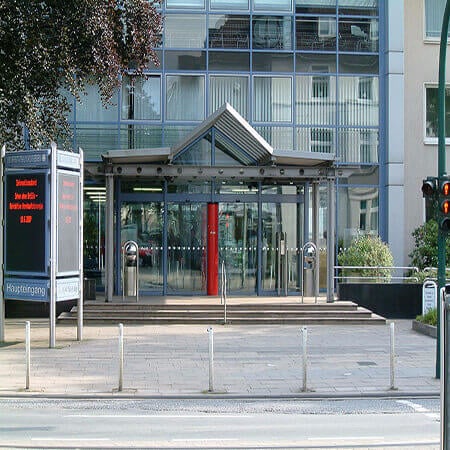Liver Cancer — Proton Therapy: treatment in the Best Hospitals in the World
Treatment prices are regulated by national law of the corresponding countries, but can also include additional hospital coefficients. In order to receive the individual cost calculation, please send us the request and medical records.

Department of Adult and Pediatric Proton Therapy
The Department of Adult and Pediatric Proton Therapy offers the full range of proton treatment and it is one of the leading and most progressive medical facilities of this kind not only in Germany, but throughout the world. The proton therapy is mostly used for the treatment of tumors of the eye, brain, spine and pelvic organs. Also, the proton therapy is an excellent treatment of tumors in children, since it has a minimal negative effect on the immature, sensitive tissues of the child’s body.







National Center for Tumor Diseases (NCT) Heidelberg
The National Center for Tumor Diseases (NCT) Heidelberg offers the full range of diagnostics and treatment of various oncological diseases. Since its foundation in 2004, the center has gained a reputation of one of the leading in Germany. The center is supported by the German Cancer Research Center (DKFZ) and the German Cancer Aid (Deutschen Krebshilfe). The center treats about 60,000 patients from 45 countries every year. Thanks to the outstanding research activities, the department has the very latest therapeutic opportunities that save lives for thousands of people.


Proton Therapy Center
The Proton Therapy Center specializes in an innovative type of radiation therapy for children, namely proton therapy. The medical facility is one of four centers in Germany offering proton therapy for cancer treatment in young patients. The center has been working since October 2015 in close cooperation with the Marburg Ion Beam Therapy Center and today can boast exceptional clinical experience in the field of its competence. Proton therapy is significantly superior to conventional radiation therapy in terms of dose control, dose distribution and side effect profile. Thus, it is an excellent alternative form of cancer treatment. The main advantage of proton therapy is that it has potentially fewer immediate and long-term side effects as compared to classical radiation therapy. The harmful effects on healthy tissues during proton therapy are minimized, which is especially important for children, as their brain and body are in the growth phase. In addition, proton therapy is provided on an outpatient basis and is an absolutely painless treatment, which is also important for young patients.

Liver cancer is an extremely aggressive tumor with high mortality rates. The problem with the treatment of this disease is that most patients suffer from cirrhosis. Many therapies cannot be used only because of the threat of severe liver failure. In such cases, doctors in developed countries use proton therapy. It allows the doctors to safely destroy the tumor with radiation even in case of a large neoplasm size, multiple tumors and severe cirrhosis.
Content
- How long has proton therapy been used for liver cancer
- What is better: proton therapy or surgery
- What is better: proton or photon radiation therapy
- What is the category of patients for whom protons are the best choice
- Faster cancer treatment: hypofractionated radiation regimen
- Treatment of cholangiocarcinoma
- Treatment of metastatic liver cancer
- Why is it worth undergoing proton therapy abroad
- Treatment in Europe with Booking Health
How long has proton therapy been used for liver cancer
For the first time, proton therapy was used for the treatment of patients with liver cancer at the University of Tsukuba, Japan, in 1985. The doctors received excellent results immediately. Until 1998, they treated 162 patients. The average tumor size was 3,8 cm. However, even with tumors more than 5 cm in diameter, the treatment results were the same as with smaller tumors. More than half of the patients had multiple liver neoplasms.
As a result, a five-year control was achieved in 86,9% of patients. No one had a grade 3 or higher toxicity. Moreover, proton beam therapy was carried out in patients, more than half of whom suffered from cirrhosis.
The treatment with proton therapy can be provided according to different regimens. The number of radiation fractions (sessions) depends on the location of the cancer. In the case of neoplasms located far from large vessels and bile ducts, the total radiation dose can be delivered in just 10 fractions. However, if the cancer is at a distance of less than 2 cm from porta hepatis, irradiation with protons is carried out in 22 fractions, and if the tumor is located up to 2 cm from the gastrointestinal organs, then the dose of radiation is provided in 35 fractions. This makes the treatment safer for patients with liver cancer. At the same time, the more fractions, the longer the course of therapy lasts.
In an analysis of 266 patients who were treated from 2001 to 2007, there was no difference in the results, depending on the fractionated radiation regimen. The five-year tumor control was 81%. Cancer treatment has proven to be safe for health. Proton therapy very rarely caused grade 3 toxicity, despite the fact that three quarters of the patients in this trial suffered from cirrhosis.
What is better: proton therapy or surgery
Surgery is considered the treatment of choice for patients with liver cancer. It provides the best survival rates for patients. However, surgery can be performed only in 20% of patients, and in the rest, cancer is considered inoperable due to an advanced stage or insufficient liver function.
In addition, a number of studies show that proton therapy provides comparable results to surgical treatment and percutaneous tumor ablation. At the same time, the method is non-invasive, rarely causes complications, does not require hospitalization and rehabilitation.
In a study by Fukuda et al proton therapy was used for patients with liver cancer who did not previously receive any treatment. The average tumor size was 4 cm, while the largest neoplasms reached 13,5 cm in diameter. One out of four patients had multiple tumors. As a result of treatment of liver cancer with protons, the five-year survival rates were as follows:
- Stage 1 – 69%.
- Stage 2 – 66%.
- Stage 3 – 25%.
It turned out that the results of proton irradiation at the early stages are about the same as after liver resection.
Other studies also detected similar results. Most of them took place in Japan and South Korea. The local tumor control rates were 80-95% for tumors 4-7 cm in size. The five-year survival rates differed depending on the stage, liver function, and cancer location. They ranged from 20 to 70%.
What is better: proton or photon radiation therapy
An international group of experts on liver cancer from 18 medical facilities met in 2019 in Miami to discuss the role of proton therapy for the treatment of this disease. They concluded that protons are not the main method of radiation therapy. Most patients will still receive photon irradiation. The main reason is the high cost of proton therapy and low availability: it is not only carried out in every city, but not even in every country. In addition, the expert group concluded that not all, but only some categories of patients can benefit from the use of protons instead of photons.
There is no doubt that proton therapy is safer. It is especially needed for patients with tumors located near the intestines, large vessels and bile ducts.
The disadvantage of photons is that they scatter a large amount of radiation as they pass through healthy tissue. They are better suited for irradiation of superficial and small neoplasms. Although beam targeting techniques are improved, post-radiation reactions are still a problem for patients with liver cancer.
At the same time, proton beams provide the following benefits:
- They release most of the radiation only upon reaching the target, namely, inside the tumor.
- They do not emit radiation at all behind the target (namely, beyond the tumor).
- They provide a more uniform dose distribution.
The experts in Miami concluded that in concomitant liver disease, especially in severe cirrhosis, as well as in large neoplasms, protons should be considered as the main method of radiation therapy. This method is not only safer for your health, but it also allows the doctors to provide treatment to even those patients for whom photon irradiation is contraindicated due to the high risk of liver failure and severe post-radiation complications from the organs adjacent to the liver.
What is the category of patients for whom protons are the best choice
It is impractical to use proton therapy treatment for all liver cancer patients. There are not enough medical resources for this. The treatment with protons instead of photons is primarily for patients with liver cancer who have:
- Developed Child-Pugh score B cirrhosis.
- Large amount of tumor tissue in a relatively healthy liver parenchyma.
- Large diameter of the neoplasm.
- Small amount of preserved healthy parenchyma.
- Multiple neoplasms.
When carrying out radiation therapy for liver cancer, it is important for doctors not only to destroy the tumor, but also to preserve the function of the organ. The liver is capable of tolerating fairly high doses of radiation. Unlike many other organs, its different parts function independently of each other. This means that it is possible to remove or destroy part of the liver with radiation, but the remaining healthy part of the parenchyma will still be able to cope with all functions. However, an important condition is that this part should really be healthy, but not to be affected by cirrhosis. Otherwise, radiation therapy becomes hazardous to health. It can cause liver failure, which will kill patients sooner than cancer.
Conventional photon radiation therapy is more toxic to the liver than protons. Therefore, many doctors are afraid to carry out cancer treatment using this method if the tumor occupies a large part of the liver. They often do not offer the patient radiation therapy for Child-Pugh score B cirrhosis. However, protons provide a more sparing suppression of tumor tissue by radiation. They do not damage the rest of the healthy parenchyma with radiation. Therefore, protons sometimes become the only possible option for radiation therapy for patients who would otherwise not receive any treatment other than palliative.
Faster cancer treatment: hypofractionated radiation regimen
During the course of therapy, either using protons or photons, the doctor has to deliver a certain dose of radiation to the tumor. It is delivered in parts, which specialists in oncology call fractions. The more fractions, the more radiation sessions a person must undergo. The courses of radiation therapy with both protons and photons usually take place once a day, 5 days a week, for one and a half to two months.
However, protons provide more accurate targeting and better radiation dose distribution. Therefore, the course of treatment can be reduced using the hypofractionated radiation regimen.
Studies show that with the proper patient selection such accelerated radiation exposure is as effective as classical fractionation. It provides comparable survival rates.
Irradiation with protons in fewer sessions is convenient for patients, especially for those who have to treat cancer abroad or have to visit the proton therapy center located in another city every day. It is possible to undergo proton therapy treatment faster, with the delivery of radiation for a smaller number of fractions, under the following conditions:
- Size of the neoplasm does not exceed 3-5 cm.
- Number of neoplasms from 1 to 3.
- No previous radiation therapy for the liver.
- Compensated cirrhosis (Child-Pugh score A) or the absence of this disease.
Treatment of cholangiocarcinoma
The main purpose of using protons is to preserve liver function while delivering a normal dose of radiation. However, the goal may be different. Doctors may want to increase the dose of radiation to ablative one. What does it mean?
Some types of cancer are resistant to radiation. For example, intrahepatic cholangiocarcinoma. This neoplasm does not grow from liver cells, but from the bile ducts located inside the liver. The use of conventional doses of radiation does not always allow the doctors to destroy the neoplasm or at least slow down its growth. If the dose of radiation is increased, this will lead to severe complications, as a result of which the treatment may become more dangerous than the disease itself.
However, the liver treated with protons can be better preserved. Doctors can deliver more radiation to the target with the help of protons. In this case, the toxicity of the treatment will be the same as when using standard photon irradiation.
Protons help to achieve an ablative dose of radiation, namely, one that suppresses cancer. The result is better local control. Studies show that achieving an ablative dose of radiation improves the total survival of patients with cholangiocarcinoma.
Currently, patients with cholangiocarcinoma are considered candidates for proton therapy:
- Inoperable – not subject to surgical removal.
- Non-metastatic – with the spread of metastases, local control of the tumor will not significantly affect life expectancy.
Treatment of metastatic liver cancer
Liver cancer can be not only primary but also metastatic. Moreover, the second option occurs 20-30 times more often. This is when a tumor initially develops not in the liver, but in another organ, for example, in the intestine. It then metastasizes to the liver. In fact, this is stage 4 cancer of a different localization.
Unlike primary cancer, metastatic cancer usually develops in patients without viral hepatitis and cirrhosis. Liver function is usually preserved. For most of these patients, conventional photon irradiation becomes an option of choice. Only a few patients require proton therapy. It may be needed in the following cases:
- Tumor is resistant to radiation.
- It is located near organs and anatomical structures, irradiation of which is undesirable.
- It has reached a large size.
An important condition: good control of the primary tumor, which is located in another organ. It has to be removed, destroyed by radiation, suppressed with chemotherapy, etc. The treatment of metastases alone does not make sense: in order to ensure control of all tumor foci, therapy must be comprehensive.
Why is it worth undergoing proton therapy abroad
Perhaps proton therapy is not yet carried out in your country.
Even if it is used, it is not a fact that doctors have vast experience in the treatment of liver cancer with this method. The organ is located in the abdominal cavity and is displaced when breathing. Both accurate targeting and breathing synchronization is important for safe exposure. Doctors at some proton therapy centers only irradiate neoplasms of the head and neck, which do not move when breathing.
If your country offers proton therapy and it is used for the treatment of liver cancer, then the price may be too high. It is likely that the cost is lower abroad.
There are several reasons for undergoing proton therapy abroad:
- You can be treated in a hospital, which uses a new technique – intensity modulated proton therapy.
- You have the opportunity to go to the proton therapy center, whose doctors have treated more than one hundred patients with liver cancer and are considered experts in this medical field.
- The ability to undergo irradiation faster – some centers use a hypofractionated radiotherapy regimen.
Treatment in Europe with Booking Health
To undergo proton therapy for liver cancer in one of the European hospitals, please use the services of the Booking Health company. On our website, you can see the cost of treatment in different hospitals, compare prices and book a medical care program at a favorable price. Proton therapy for liver cancer in a European hospital will be easier and faster for you, and the cost of treatment will be reduced.
Please leave your request on the Booking Health website. Our employee will contact you and provide a consultation about treatment in Europe. Booking Health will take care of the organization of your trip. We will provide the following benefits for you:
- We will select a hospital for treatment in Europe, whose doctors use proton therapy for liver cancer.
- We will help you overcome the language barrier, establish communication with your attending physician.
- We will reduce the waiting time for the start of the medical care program and book a doctor's appointment on the most suitable dates.
- We will reduce the price. The cost of treatment in European hospitals will be decreased due to the lack of additional coefficients for foreign patients.
- We will take care of all organizational issues: documents for entering the country, transfer from the airport, hotel, interpreting services, etc.
- We will prepare a program and translate medical documents. You do not have to repeat the previously performed diagnostic procedures.
- We will provide communication with the hospital after treatment in Europe.
- We will organize additional diagnostic examinations and treatment in a European hospital, if necessary.
- We will buy medicines abroad and forward them to your native country.
- We will help you keep in touch with the hospital and the doctor after treatment in Europe.
You will receive treatment from the best doctors in the world. The Booking Health employees will help reduce the cost of treatment and take care of all organizational issues, and you will only have to focus on restoring your health.
Authors: Dr. Nadezhda Ivanisova, Dr. Sergey Pashchenko

